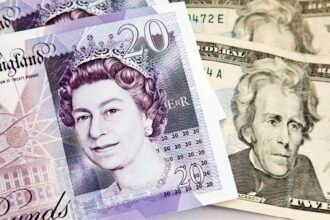- GBP/USD trades near 1.3400 as markets assess UK employment data.
- The near-term technical outlook shows no signs of an extended recovery.
- Markets await weekly Initial Jobless Claims and Retail Sales data from the US.
GBP/USD trades marginally lower on the day at around 1.3400 in the European session on Thursday. Although Pound Sterling gathers strength against other major currencies, GBP/USD’s technical outlook is yet to point to a buildup of recovery momentum.
British Pound PRICE Today
The table below shows the percentage change of British Pound (GBP) against listed major currencies today. British Pound was the strongest against the Australian Dollar.
| USD | EUR | GBP | JPY | CAD | AUD | NZD | CHF | |
|---|---|---|---|---|---|---|---|---|
| USD | 0.44% | 0.13% | 0.55% | 0.52% | 0.91% | 0.46% | 0.42% | |
| EUR | -0.44% | -0.31% | 0.09% | 0.11% | 0.50% | 0.05% | 0.02% | |
| GBP | -0.13% | 0.31% | 0.44% | 0.39% | 0.78% | 0.34% | 0.30% | |
| JPY | -0.55% | -0.09% | -0.44% | -0.06% | 0.31% | -0.10% | -0.14% | |
| CAD | -0.52% | -0.11% | -0.39% | 0.06% | 0.47% | -0.06% | -0.09% | |
| AUD | -0.91% | -0.50% | -0.78% | -0.31% | -0.47% | -0.53% | -0.48% | |
| NZD | -0.46% | -0.05% | -0.34% | 0.10% | 0.06% | 0.53% | -0.03% | |
| CHF | -0.42% | -0.02% | -0.30% | 0.14% | 0.09% | 0.48% | 0.03% |
The heat map shows percentage changes of major currencies against each other. The base currency is picked from the left column, while the quote currency is picked from the top row. For example, if you pick the British Pound from the left column and move along the horizontal line to the US Dollar, the percentage change displayed in the box will represent GBP (base)/USD (quote).
The UK’s Office for National Statistics (ONS) reported early Thursday that the ILO Unemployment Rate edged higher to 4.7% in the three months to May from 4.6%. In this period, Employment Change rose by 134,000, following the 89,000 increase recorded previously. Finally, annual wage inflation, as measured by the change in Average Earnings Excluding Bonus, declined to 5%, coming in above the market expectation of 4.9%.
Reflecting the positive impact of the employment report on Pound Sterling, EUR/GBP was last seen losing 0.3%, while GBP/JPY was up nearly 0.5% on the day. Nevertheless, the US Dollar (USD) benefits from the cautious market mood and doesn’t allow GBP/USD to gain traction.
Later in the day, weekly Initial Jobless Claims and June Retail Sales data will be featured in the US economic calendar.
Markets expect the number of first-time applications for unemployment benefits to rise to 235,000 from 227,000 in the previous week. A reading below 220,000 could support the USD with the immediate reaction and make it difficult for GBP/USD to hold its ground. Conversely, a disappointing reading of 240,000 or above could open the door for a rebound in the pair.
GBP/USD Technical Analysis

The Relative Strength Index (RSI) indicator on the 4-hour chart stays below 40, reflecting bearish conditions for GBP/USD. The Fibonacci 61.8% retracement level of the latest uptrend seems to have formed a pivot level at 1.3400.
In case GBP/USD fails to stabilize above 1.3400, technical sellers could remain interested. In this scenario, 1.3300 (Fibonacci 78.6% retracement) and 1.3275 (100-day Simple Moving Average) could be seen as next support levels. On the upside, resistance levels could be spotted at 1.3470 (Fibonacci 50% retracement), 1.3500 (static level, round level) and 1.3540 (Fibonacci 38.2% retracement).
GDP FAQs
A country’s Gross Domestic Product (GDP) measures the rate of growth of its economy over a given period of time, usually a quarter. The most reliable figures are those that compare GDP to the previous quarter e.g Q2 of 2023 vs Q1 of 2023, or to the same period in the previous year, e.g Q2 of 2023 vs Q2 of 2022.
Annualized quarterly GDP figures extrapolate the growth rate of the quarter as if it were constant for the rest of the year. These can be misleading, however, if temporary shocks impact growth in one quarter but are unlikely to last all year – such as happened in the first quarter of 2020 at the outbreak of the covid pandemic, when growth plummeted.
A higher GDP result is generally positive for a nation’s currency as it reflects a growing economy, which is more likely to produce goods and services that can be exported, as well as attracting higher foreign investment. By the same token, when GDP falls it is usually negative for the currency.
When an economy grows people tend to spend more, which leads to inflation. The country’s central bank then has to put up interest rates to combat the inflation with the side effect of attracting more capital inflows from global investors, thus helping the local currency appreciate.
When an economy grows and GDP is rising, people tend to spend more which leads to inflation. The country’s central bank then has to put up interest rates to combat the inflation. Higher interest rates are negative for Gold because they increase the opportunity-cost of holding Gold versus placing the money in a cash deposit account. Therefore, a higher GDP growth rate is usually a bearish factor for Gold price.




















